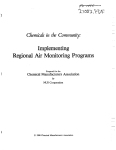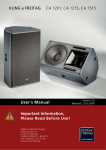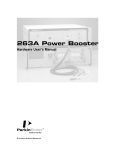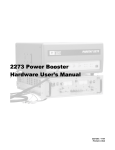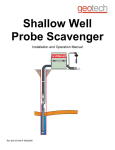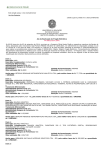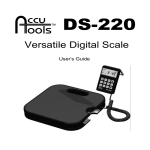Download Manual
Transcript
Metrohm Martindale Electric Metrohm House, Imperial Park, Imperial Way, Watford, Hertfordshire, WD24 4PP, UK T: 01923 441717 F: 01923 446900 Email: [email protected] web: www.martindale-electric.co.uk ® 7A501 EXTRA SAFE INSULATION & CONTINUITY TESTERS INSTRUCTION MANUAL CMR0011 ISSUE 10 01/04 Metrohm Martindale Electric Metrohm House Penfold Trading Estate Imperial Way Watford WD24 4YY T: 01923 441717 F: 01923 446900 Email: [email protected] web: www.martindale-electric.co.uk CMR0011 ISSUE 10 01/04 7A501 EXTRA SAFE INSULATION & CONTINUITY TESTERS INSTRUCTION MANUAL ® . LIMITED WARRANTY Martindale Electric Company Ltd warrants instruments and test equipment manufactured by them to be free from defective material or factory workmanship and agree to repair or replace such products which, under normal use and service, disclose the defect to be the fault of our manufacturing, with no charge for parts and service. If we are unable to repair or replace the product, we will make a refund of the purchase price. Consult the Instruction Manual for instructions regarding the proper use and servicing of instruments and test equipment. Our obligation under this warranty is limited to repairing, replacing or making refund of any instrument or test equipment which proves to be defective within twenty four months from the date of original purchase. This warranty does not apply to any of our products which have been repaired or altered by unauthorised persons in any way so as, in our sole judgement, to injure their stability or reliability, or which have been subject to misuse, abuse, misapplication, negligence, accident or which have had the serial numbers altered, defaced or removed. Accessories, not of our manufacture used with this product, are not covered by this warranty. TABLE OF CONTENTS PAGE SAFETY RULES 2-4 GENERAL DESCRIPTION 5 7A501 OPERATING INSTRUCTIONS 6-7 7A501 SPECIFICATION 8-9 SPARES AND ACCESSORIES 9 REPAIRS 9 TABLE 1 10-11 LIMITED WARRANTY 12 TABLE OF CONTENTS PAGE SAFETY RULES 2-4 GENERAL DESCRIPTION 5 7A501 OPERATING INSTRUCTIONS 6-7 7A501 SPECIFICATION 8-9 SPARES AND ACCESSORIES 9 REPAIRS 9 TABLE 1 10-11 LIMITED WARRANTY 12 To register a claim under the provisions of this warranty, return the instrument or test equipment to. Martindale Electric Company Ltd, Metrohn House, Penfold Trading Estate, Imperial Way, Watford. Upon our receipt and inspection of the product we will advise you as to the disposition of your claim. ALL WARRANTIES IMPLIED BY LAW ARE HEREBY LIMITED TO A PERIOD OF TWENTY FOUR MONTHS, AND THE PROVISIONS OF THE WARRANTY ARE EXPRESSLY IN LIEU OF ANY OTHER WARRANTIES EXPRESSED OR IMPLIED. The purchaser agrees to assume all liability for any damages and bodily injury which may result from the use or misuse of the product by the purchaser, his employees, or others, and the remedies provided for in this warranty are expressly in lieu of any other liability Martindale Electric Company Ltd may have, including incidental or consequential damages. LIMITED WARRANTY Martindale Electric Company Ltd warrants instruments and test equipment manufactured by them to be free from defective material or factory workmanship and agree to repair or replace such products which, under normal use and service, disclose the defect to be the fault of our manufacturing, with no charge for parts and service. If we are unable to repair or replace the product, we will make a refund of the purchase price. Consult the Instruction Manual for instructions regarding the proper use and servicing of instruments and test equipment. Our obligation under this warranty is limited to repairing, replacing or making refund of any instrument or test equipment which proves to be defective within twenty four months from the date of original purchase. This warranty does not apply to any of our products which have been repaired or altered by unauthorised persons in any way so as, in our sole judgement, to injure their stability or reliability, or which have been subject to misuse, abuse, misapplication, negligence, accident or which have had the serial numbers altered, defaced or removed. Accessories, not of our manufacture used with this product, are not covered by this warranty. To register a claim under the provisions of this warranty, return the instrument or test equipment to. Martindale Electric Company Ltd, Metrohn House, Penfold Trading Estate, Imperial Way, Watford. Upon our receipt and inspection of the product we will advise you as to the disposition of your claim. ALL WARRANTIES IMPLIED BY LAW ARE HEREBY LIMITED TO A PERIOD OF TWENTY FOUR MONTHS, AND THE PROVISIONS OF THE WARRANTY ARE EXPRESSLY IN LIEU OF ANY OTHER WARRANTIES EXPRESSED OR IMPLIED. The purchaser agrees to assume all liability for any damages and bodily injury which may result from the use or misuse of the product by the purchaser, his employees, or others, and the remedies provided for in this warranty are expressly in lieu of any other liability Martindale Electric Company Ltd may have, including incidental or consequential damages. CLASS SAFETY RULES CLASS GAS OR VAPOUR Esters methyl formate ethyl formate methyl acetate ethyl acetate butyl acetate amyl acetate methyl acetoacetate diethyl oxalate methyl acrylate ethyl acrylate 2c (cont.) WARNING (ii) Compounds containing oxygen Oxides (including ethers) carbon monoxide methoxyethanol ethoxyethanol ethyldigol butyldigol dibutyl ether DISCONNECT TEST LEADS BEFORE OPENING TESTER. This tester has been designed with your safety in mind. However, no design can completely protect against incorrect use. Electrical circuits can be dangerous and/or lethal when lack of caution or poor safety practices are used. (iii) Compounds Containing Halogens Compounds without oxygen chloromethane chloroethane bromoethane chloropropane chlorobutane bromobutane dichloroethane dichloropropane chlorobenzene benzyl chloride dichlorobenzene allyl chloride dichloroethylene chloroethylene When using this tester to monitor high voltages turn off the power before connecting the tester. Where possible, do not touch the tester or its leads when the power is on. Turn off the power before disconnecting the tester. (iv) Compounds Containing Nitrogen Amines methylamine dimethylamine trimethylamine diethylamine triethylamine propylamine butylamine cyclohexylamine ethanolamine diethylaminoethanol diaminoethane aniline dimethylaniline amphetamine toluidine pyridine Compounds with oxygen acetyl chloride chloroethanol chlordimethyl ether READ THE MANUAL Read this Instruction Manual carefully and completely. Voltages within the capability of this tester can be hazardous. Follow the instructions in this manual for every measurement. Read and understand the general instructions before attempting to use this tester. Amides formdimethylamide Nitro-compounds nitromethane nitroethane nitrobenzene Acids acetic acid (v) Compounds Containing Sulphar ethyl mercaptan diethyl sulphate -2- -11- CLASS SAFETY RULES CLASS GAS OR VAPOUR Esters methyl formate ethyl formate methyl acetate ethyl acetate butyl acetate amyl acetate methyl acetoacetate diethyl oxalate methyl acrylate ethyl acrylate 2c (cont.) WARNING DISCONNECT TEST LEADS BEFORE OPENING TESTER. This tester has been designed with your safety in mind. However, no design can completely protect against incorrect use. Electrical circuits can be dangerous and/or lethal when lack of caution or poor safety practices are used. When using this tester to monitor high voltages turn off the power before connecting the tester. Where possible, do not touch the tester or its leads when the power is on. Turn off the power before disconnecting the tester. (ii) Compounds containing oxygen Oxides (including ethers) carbon monoxide methoxyethanol ethoxyethanol ethyldigol butyldigol dibutyl ether (iii) Compounds Containing Halogens Compounds without oxygen chloromethane chloroethane bromoethane chloropropane chlorobutane bromobutane dichloroethane dichloropropane chlorobenzene benzyl chloride dichlorobenzene allyl chloride dichloroethylene chloroethylene (iv) Compounds Containing Nitrogen Amines methylamine dimethylamine trimethylamine diethylamine triethylamine propylamine butylamine cyclohexylamine ethanolamine diethylaminoethanol diaminoethane aniline dimethylaniline amphetamine toluidine pyridine Compounds with oxygen acetyl chloride chloroethanol chlordimethyl ether READ THE MANUAL Read this Instruction Manual carefully and completely. Voltages within the capability of this tester can be hazardous. Follow the instructions in this manual for every measurement. Read and understand the general instructions before attempting to use this tester. -2- Amides formdimethylamide Nitro-compounds nitromethane nitroethane nitrobenzene Acids acetic acid (v) Compounds Containing Sulphar ethyl mercaptan diethyl sulphate -11- CLASS 1 2a †2c CLASS GAS OR VAPOUR Methane (firedamp) Ammonia (i) Hydrocarbons Alkane methane*(industrial) ethane propane butane pentane hexane heptane nonane cyclobutane cyclohexane methylcyclohexane decahydronaphthalene Alcohols and Phenols methanol ethanol propanol butanol pentanol hexanol octanol nonanol cyclohexanol methylcyclohexanol diacetone alcohol phenol cresol Benzenoid benzene toluene xylene ethylbenzene trimethyIbenzene aphthalene Aldehydes formaldehyde acetaldehyde octaldehyde paraformaldehyde paraldehyden metaldehyde benzaldehyde butyraldehyde Alkene butene cyclohexene styrene di-isobutylene Ketones acetone ethyl methyl ketone propyl methyl ketone butyl methyl ketone amyl methyl ketone acetylacetone cyclohexanone Mixed Hydrocarbons turpentine coal tar naphtha petroleum naphtha kerosene SAFETY CHECK Double check the switch setting and lead connections before making measurements. Are you following instructions? When changing the battery or removing the cover to access the internal circuitry, always disconnect the test leads. DON’T TOUCH Don’t touch exposed wiring, connections or other ‘live’ parts of an electrical circuit. If in doubt, check the circuit first for voltage before touching it. Turn off the power to a circuit before connecting test probes to it. Be sure there is no voltage present before you touch the circuit. Do not use cracked or broken test leads. HIGH VOLTAGE IS DANGEROUS Always start with the power turned off. Be sure these is no voltage present before making connections to the circuit. Before disconnecting the tester, turn the circuit off and wait for the meter to return to ‘zero’. HAZARDOUS LOCATIONS In hazardous locations where inflammable gases may be present, it is important to remember certain precautions must be taken These are: 1 DO NOT FLICK THE TEST LEADS 2 CONNECT TEST LEADS SECURELY TO CIRCUIT UNDER TEST 3 RELEASE OPERATING BUTTON BEFORE DISCONNECTING TEST LEADS -10- CLASS 1 2a †2c -3- CLASS GAS OR VAPOUR Methane (firedamp) Ammonia (i) Hydrocarbons Alkane methane*(industrial) ethane propane butane pentane hexane heptane nonane cyclobutane cyclohexane methylcyclohexane decahydronaphthalene Alcohols and Phenols methanol ethanol propanol butanol pentanol hexanol octanol nonanol cyclohexanol methylcyclohexanol diacetone alcohol phenol cresol Benzenoid benzene toluene xylene ethylbenzene trimethyIbenzene aphthalene Aldehydes formaldehyde acetaldehyde octaldehyde paraformaldehyde paraldehyden metaldehyde benzaldehyde butyraldehyde Alkene butene cyclohexene styrene di-isobutylene Ketones acetone ethyl methyl ketone propyl methyl ketone butyl methyl ketone amyl methyl ketone acetylacetone cyclohexanone Mixed Hydrocarbons turpentine coal tar naphtha petroleum naphtha kerosene -10- SAFETY CHECK Double check the switch setting and lead connections before making measurements. Are you following instructions? When changing the battery or removing the cover to access the internal circuitry, always disconnect the test leads. DON’T TOUCH Don’t touch exposed wiring, connections or other ‘live’ parts of an electrical circuit. If in doubt, check the circuit first for voltage before touching it. Turn off the power to a circuit before connecting test probes to it. Be sure there is no voltage present before you touch the circuit. Do not use cracked or broken test leads. HIGH VOLTAGE IS DANGEROUS Always start with the power turned off. Be sure these is no voltage present before making connections to the circuit. Before disconnecting the tester, turn the circuit off and wait for the meter to return to ‘zero’. HAZARDOUS LOCATIONS In hazardous locations where inflammable gases may be present, it is important to remember certain precautions must be taken These are: 1 DO NOT FLICK THE TEST LEADS 2 CONNECT TEST LEADS SECURELY TO CIRCUIT UNDER TEST 3 RELEASE OPERATING BUTTON BEFORE DISCONNECTING TEST LEADS -3- NOTE: BS1259 is now obsolescent and has been superseded by BS5501. Under BS1259 the tester by itself was approved whereas under BS5501 approvals also consider applications of the tester. For example when carrying out insulation testing at 500V DC on wiring installations the inherent self-capacitance of the wiring will charge up and could create an incendive spark if discharged accidentally. It is necessary therefore to have a good working code of practice so that this hazard is eliminated and to ensure that the charge held in the wiring capacitance is discharged safely via the tester at the end of each insulation test. (C) ENVIRONMENTAL Operating Temperature: 0 to 40ºC Storage Temperature: -20ºC to 60ºC SPARES AND ACCESSORIES (7A501) Leads: Carry Case: Battery: 7A501 1.5V IEC R6B METDFK0113 METPA24249A CEJ0035 THIS INSTRUMENT SHOULD ONLY BE USED BY A COMPETENT, SUITABLY TRAINED PERSON. REMEMBER: SAFETY IS NO ACCIDENT REPAIRS Martindale Electric Company LTD Metrohm House Penfold Trading Estate Imperial Way Watford WD24 4YY T: 01923 441717 F: 01923 446900 Email: [email protected] web: www.martindale-electric.co.uk -4- NOTE: BS1259 is now obsolescent and has been superseded by BS5501. Under BS1259 the tester by itself was approved whereas under BS5501 approvals also consider applications of the tester. For example when carrying out insulation testing at 500V DC on wiring installations the inherent self-capacitance of the wiring will charge up and could create an incendive spark if discharged accidentally. It is necessary therefore to have a good working code of practice so that this hazard is eliminated and to ensure that the charge held in the wiring capacitance is discharged safely via the tester at the end of each insulation test. -9- (C) ENVIRONMENTAL Operating Temperature: 0 to 40ºC Storage Temperature: -20ºC to 60ºC SPARES AND ACCESSORIES (7A501) Leads: Carry Case: Battery: 7A501 1.5V IEC R6B THIS INSTRUMENT SHOULD ONLY BE USED BY A COMPETENT, SUITABLY TRAINED PERSON. REMEMBER: SAFETY IS NO ACCIDENT REPAIRS Martindale Electric Company LTD Metrohm House Penfold Trading Estate Imperial Way Watford WD24 4YY T: 01923 441717 F: 01923 446900 Email: [email protected] web: www.martindale-electric.co.uk -4- -9- METDFK0113 METPA24249A CEJ0035 7A501 SPECIFICATION GENERAL DESCRIPTION (A) ELECTRICAL The 7A501 has been approved to BS1259 (1958) and carries the Ministry of Power Certificate Number IS1428 (Class 1)and the Factory Inspectorate Certificate Number 2148 (Class 2A and 2C) which covers Methane, Ammonia and Hydrocarbons. Table 1 gives a full list of gases and vapours that are covered. Insulation MΩ Range: Test Voltage: Short Circuit Current: Accuracy: 0 - 50MΩ 500V DC±10% across 1MΩ <2mA ±1.6mm of scale arc length Continuity Ω Range: Test Voltage: Short Circuit Current: Accuracy 0 - 50Ω Nominal 200mV <26mA : ±1.6mm of scale arc length Battery: 6 off 1.5V AA IEC R6B EMC: Meets The testers have an analogue display and 500V DC insulation test voltage with a short circuit current of less than 2mA. On continuity the test voltage is nominally 200mV with a short circuit current of 26mA maximum. A special allen key is required to access the batteries so that they may not be changed in a hazardous area. This tester does not comply with The ATEX directive. BS EN 50081-1 BS EN 50082-1 (B) MECHANICAL Size: Material: Weight: Movement: Scale Length: Test Leads: 132 X 82 X 60mm ABS 0.6kg Nominal1.0mA sensitivity taut band 70mm 914mm long with crocodile clips -8- -5- 7A501 SPECIFICATION GENERAL DESCRIPTION (A) ELECTRICAL The 7A501 has been approved to BS1259 (1958) and carries the Ministry of Power Certificate Number IS1428 (Class 1)and the Factory Inspectorate Certificate Number 2148 (Class 2A and 2C) which covers Methane, Ammonia and Hydrocarbons. Table 1 gives a full list of gases and vapours that are covered. Insulation MΩ Range: Test Voltage: Short Circuit Current: Accuracy: 0 - 50MΩ 500V DC±10% across 1MΩ <2mA ±1.6mm of scale arc length Continuity Ω Range: Test Voltage: Short Circuit Current: Accuracy 0 - 50Ω Nominal 200mV <26mA : ±1.6mm of scale arc length Battery: 6 off 1.5V AA IEC R6B EMC: Meets The testers have an analogue display and 500V DC insulation test voltage with a short circuit current of less than 2mA. On continuity the test voltage is nominally 200mV with a short circuit current of 26mA maximum. A special allen key is required to access the batteries so that they may not be changed in a hazardous area. This tester does not comply with The ATEX directive. BS EN 50081-1 BS EN 50082-1 (B) MECHANICAL Size: Material: Weight: Movement: Scale Length: Test Leads: 132 X 82 X 60mm ABS 0.6kg Nominal1.0mA sensitivity taut band 70mm 914mm long with crocodile clips -8- -5- 7A501 OPERATING INSTRUCTIONS ZERO ADJUST If the pointer does not coincide with the zero on the left side of the scale, adjust as required with a screwdriver inserted through the hole in the back of the case. BATTERY TEST Connect the test terminals together with the test leads and operate the right (MΩ) side of the test switch. The pointer should read zero on the top MΩ scale. If not replace the batteries. BATTERY REPLACEMENT Fig. 1 Front Layout of 7A501 The test switch is operated with a rocker button so that depressing and holding the left side measures continuity and depressing and holding the right side measures insulation. Readings are displayed on an analogue meter. If the pointer deflects upscale when the test leads are connected to a circuit it indicates that the circuit is live and operating the test switch could result in damage to the tester. Disconnect the leads from the circuit. Before using the tester check the pointer zero and the battery condition. The batteries must never be replaced in a hazardous area. The carry case must first be removed by unscrewing the allen screw (with the special key provided) in the retaining strap. To access the batteries remove the battery lid by undoing the screw at the rear of the tester with the special key. Remove the spent batteries, insert new ones and reassemble. CONTINUITY 0 - 50Ω. Continuity resistance is displayed on the meter when the left side (Ω) of the test switch is operated. INSULATION 0 - 50MΩ. Insulation resistance is displayed on the meter when the right side (MΩ) of the test switch is operated. -6- 7A501 OPERATING INSTRUCTIONS -7- ZERO ADJUST If the pointer does not coincide with the zero on the left side of the scale, adjust as required with a screwdriver inserted through the hole in the back of the case. BATTERY TEST Connect the test terminals together with the test leads and operate the right (MΩ) side of the test switch. The pointer should read zero on the top MΩ scale. If not replace the batteries. BATTERY REPLACEMENT Fig. 1 Front Layout of 7A501 The test switch is operated with a rocker button so that depressing and holding the left side measures continuity and depressing and holding the right side measures insulation. Readings are displayed on an analogue meter. If the pointer deflects upscale when the test leads are connected to a circuit it indicates that the circuit is live and operating the test switch could result in damage to the tester. Disconnect the leads from the circuit. Before using the tester check the pointer zero and the battery condition. -6- The batteries must never be replaced in a hazardous area. The carry case must first be removed by unscrewing the allen screw (with the special key provided) in the retaining strap. To access the batteries remove the battery lid by undoing the screw at the rear of the tester with the special key. Remove the spent batteries, insert new ones and reassemble. CONTINUITY 0 - 50Ω. Continuity resistance is displayed on the meter when the left side (Ω) of the test switch is operated. INSULATION 0 - 50MΩ. Insulation resistance is displayed on the meter when the right side (MΩ) of the test switch is operated. -7-








